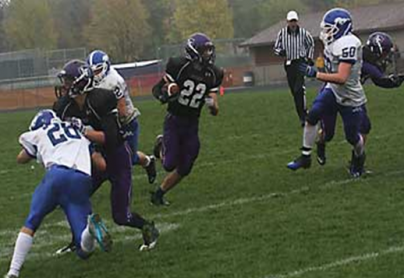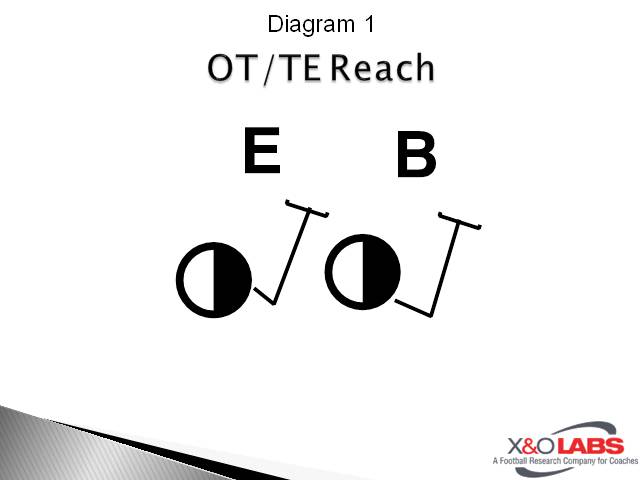By Jay DeCann
Head Coach/Offensive Coordinator
Little Falls High School (MN)
Editor's Note: Coach DeCann is entering his 3rd year as head coach/offensive coordinator at Little Falls High School. Coach DeCann is entering his 25th year of coaching high school and college football. DeCann has been apart of 6 conference championships and two NAIA national playoff runs.
 We have been an inside and outside zone team for a long time and had great success with the inside zone play, but really struggled with consistency with the outside zone play with the Rip/Reach/Overtake concept. We just had a very difficult time with displacing and getting movement on the down defenders and creating an edge for the outside zone. In 2003 I was very fortunate to spend some time with former University of Minnesota offensive line coach Gordy Shaw, who at the time was apart of one of the best running games in the country running inside zone and pin and pull stretch play. The piece of this concept was it gave us a great C and D gap play for our tailback that was a perfect marriage with our inside zone run game. The backfield action was very similar to what we were doing with our outside zone play so it was just a matter of teaching the new concept to our offensive line and tight ends.
We have been an inside and outside zone team for a long time and had great success with the inside zone play, but really struggled with consistency with the outside zone play with the Rip/Reach/Overtake concept. We just had a very difficult time with displacing and getting movement on the down defenders and creating an edge for the outside zone. In 2003 I was very fortunate to spend some time with former University of Minnesota offensive line coach Gordy Shaw, who at the time was apart of one of the best running games in the country running inside zone and pin and pull stretch play. The piece of this concept was it gave us a great C and D gap play for our tailback that was a perfect marriage with our inside zone run game. The backfield action was very similar to what we were doing with our outside zone play so it was just a matter of teaching the new concept to our offensive line and tight ends.
We really liked that there was not a laundry list of rules for the offensive line, but concepts for the offensive line and tight ends working in tandems. The main premise of the play is to make linebackers become 2 gap defenders and it allowed our tailback to read the block of the tight end and was a 2 gap play for us by pounding it into C gap or bursting off the edge into D gap.
We try and maintain our normal splits with our offensive linemen and tight ends on our pin and pull play. As most coaches I talk to, we have linemen who like to cheat their splits and narrow up because of fear of betting beat inside, and so our splits will tend to be any where from 18” to 24” with the offensive line and tight ends 24” to 30”. Our vertical alignment we like to be slightly off the ball and have our linemen and tight ends line up with their helmets aligned on the rib cage of the center. We teach a balanced stance with not much of a stagger with our feet and coach our offensive line to have approximately 40% of their weight up on their down hand.
Offensive Tackle/Tight End Tandem
The tight end is the player who will make the call. The tight end has 3 common looks that he needs to understand the concept of this tandem:
- OT and TE covered= Reach
- OT uncovered and Linebacker inside = Slug
- Swap: OT uncovered and linebacker outside= Swap
The 3 schemes this tandem needs to understand are reach, scoop and pin and pull.
Reach Scheme:
We teach our guys to step at a 45-degree angle play side and their aiming point is the outside armpit. The 2nd step we coach them to step into the crotch of the defender, as the outside hand should be thrown into the far armpit area and the backside hand into the bottom of the shoulder pads. Head should be fit into the rib cage of the down defender and we continue to run our feet trying to work the defender for width or vertical push. You will see as we go on that we are OK with the down defenders either getting reached or displaced outside with the read of the tailback on the tight end block.

Slug Scheme:
The Slug scheme is used when the offensive tackle is uncovered and the linebacker is inside the box. We teach our covered player to take a “Slide Step” which is a lateral step. The length of the step will depend up on the alignment of the down defender. We tell the covered player his aiming point is the play side number, so we need to slide step to get our eyes on the play side number and fit our eyebrows on the play side number. 2nd step again is to the crotch of the defender and hands inside on the down defender. Again, we can displace the down defender for width or work a vertical push to 2nd level. The uncovered lineman will take a 45-degree step with the aiming point the backside number. We want this player to assume he will be overtaking the block, but do not chase the number. If the number disappears we stay on our track for 2nd level defender.









